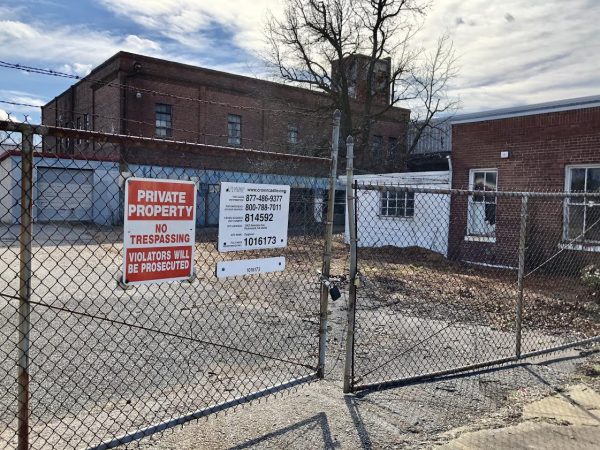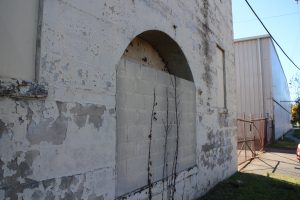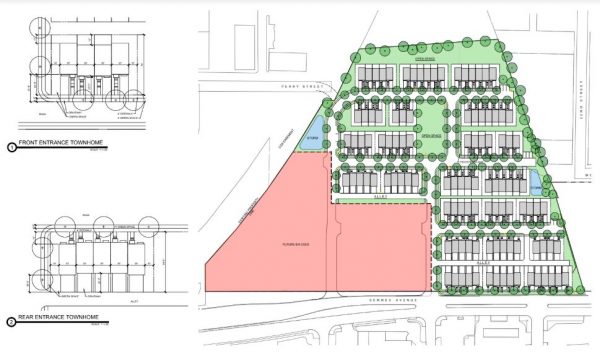
A 300,000-square-foot warehouse complex at 1802 Semmes Ave. is set to be razed for a new mixed-use development. (BizSense file photo by J. Elias O’Neal)
The city’s Southside is set to get a new dose of single-family residential density.
City Council voted Monday night to grant a special-use permit for Belle Heights, a planned 106-unit townhome development at 1802 Semmes Ave. in the Swansboro neighborhood.
Local development firm Harper & Associates acquired the roughly 13-acre parcel in 2015 for $3.7 million, with hopes of developing it into a grocery-anchored development.
Harper scrapped those plans when it couldn’t secure a grocery tenant, and this year it submitted plans to turn the site, which currently houses warehouses, into a mixed-use development with 106 new townhomes and about 4 acres of commercial space.
City Council voted unanimously to grant the SUP, which was needed to build the residential units. The SUP request was listed on council’s consent agenda, which contains ordinances that are considered “routine and non-controversial”.
Still, there was some conversation regarding the SUP at Monday’s meeting. Two local residents presented their concerns regarding traffic the development may cause, and whether vinyl siding may be used on the townhomes. Williams Mullen attorney Preston Lloyd, who is representing Harper, spoke in favor of it.
Councilmembers Parker Agelasto, Kim Gray and Kristen Larson all echoed citizens’ concern regarding traffic, but ultimately approved the permit.

A 300,000-square-foot warehouse complex at 1802 Semmes Ave. is set to be razed for a new mixed-use development. (BizSense file photo by J. Elias O’Neal)
The city’s Southside is set to get a new dose of single-family residential density.
City Council voted Monday night to grant a special-use permit for Belle Heights, a planned 106-unit townhome development at 1802 Semmes Ave. in the Swansboro neighborhood.
Local development firm Harper & Associates acquired the roughly 13-acre parcel in 2015 for $3.7 million, with hopes of developing it into a grocery-anchored development.
Harper scrapped those plans when it couldn’t secure a grocery tenant, and this year it submitted plans to turn the site, which currently houses warehouses, into a mixed-use development with 106 new townhomes and about 4 acres of commercial space.
City Council voted unanimously to grant the SUP, which was needed to build the residential units. The SUP request was listed on council’s consent agenda, which contains ordinances that are considered “routine and non-controversial”.
Still, there was some conversation regarding the SUP at Monday’s meeting. Two local residents presented their concerns regarding traffic the development may cause, and whether vinyl siding may be used on the townhomes. Williams Mullen attorney Preston Lloyd, who is representing Harper, spoke in favor of it.
Councilmembers Parker Agelasto, Kim Gray and Kristen Larson all echoed citizens’ concern regarding traffic, but ultimately approved the permit.





This is a positive step forward for the neighborhood. More home ownership means more pressure on the schools to improve performance, more demands for police presence, and another reason for a grocer to consider a store to serve the growing population.
This is not a mixed use development, please get your terms correct! You are consistently incorrectly describing projects like this as mixed use. This is a residential area next to a commercial area… no mixing of uses! This is typical of any suburban development in Anytown, USA.
In defense of the author, “mixed use” developments can include developments where multiple functions are “mixed” through adjacency.
Mixed-use development is defined as a project where residents can do other things (like work, be entertained, dine) while using pedestrian connections. Other neighbors may benefit from the uses, but a combination of the uses within the development indeed makes it a”mixed -use” development
From a planner’s term it is NOT mixed use. The term , per ULI (Urban Land Institute) Mixed-Use Development Handbook and the APA , characterizes mixed-use development as one that 1) provides three or more significant revenue-producing uses (such as retail/entertainment, office, residential, hotel, and/or civic/cultural/recreation), 2) fosters integration, density, and compatibility of land uses, and 3) creates a walkable community with uninterrupted pedestrian connections. Retail and residential beside each other is not mixed use. Glad for the development and I hope they connect the neighborhood sidewalks to the City sidewalks but this,as Brett says, this not a mixed use… Read more »
Michael, (and Brett) the commercial component can have any use that is B-6 Mixed use (includes restaurants, entertainment, offices, galleries, museums, etc.) Has their been an indication that it will all be commercial? (I don’t know). It seems like the different categories you list above may very well be allowed. If so, is the description accurate? I’m certainly not as well versed is you, and I’m here to learn. It just seems like an appropriate description, even based on the ULI definitions.
As always, I enjoy and appreciate your input and information.
Matt to give a good example Libbie Mill has retail component, the civic component of a library, and housing. West Broad Village has housing, hotel, retail and had civic (CMoR moved). This proposed retail, based on the roads layout, will not likely be connected to the housing. Someone got an SUP to split a parcel of land that was M-1 into two sections so they could redevelop the site. This SUP has a retail parcel (or two) on the front and housing in the back. If this is mixed use that means ever piece of land along Hull Street, Midlothian… Read more »
Thanks, Michael. It looks to me like the streets will in fact tie the residential grid into the future developed area. Other than the initial access won’t all residential traffic have to go through the commercial component? I don’t see where all of the commercial will be retail, but I suspect you’re far more familiar with this case.
Thanks for the explanation. It helps. I’m a CE, not a planner. These cases pique my interest. Your explanations are much appreciated.